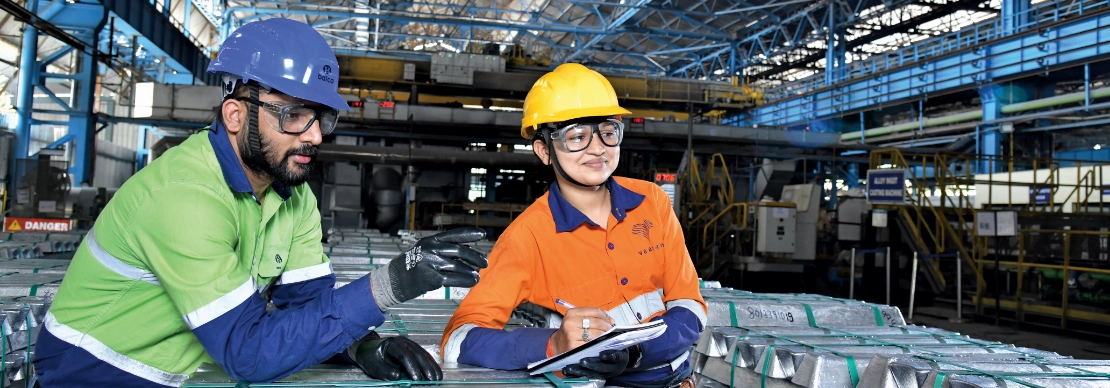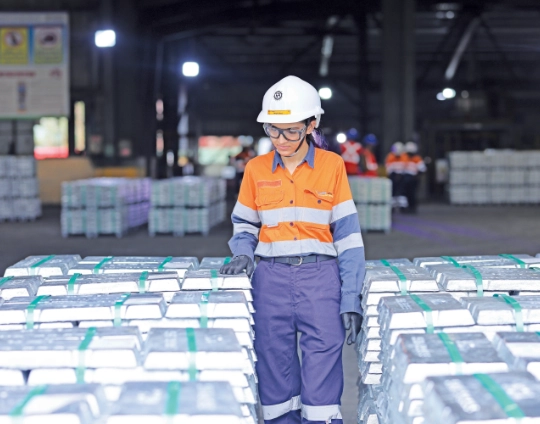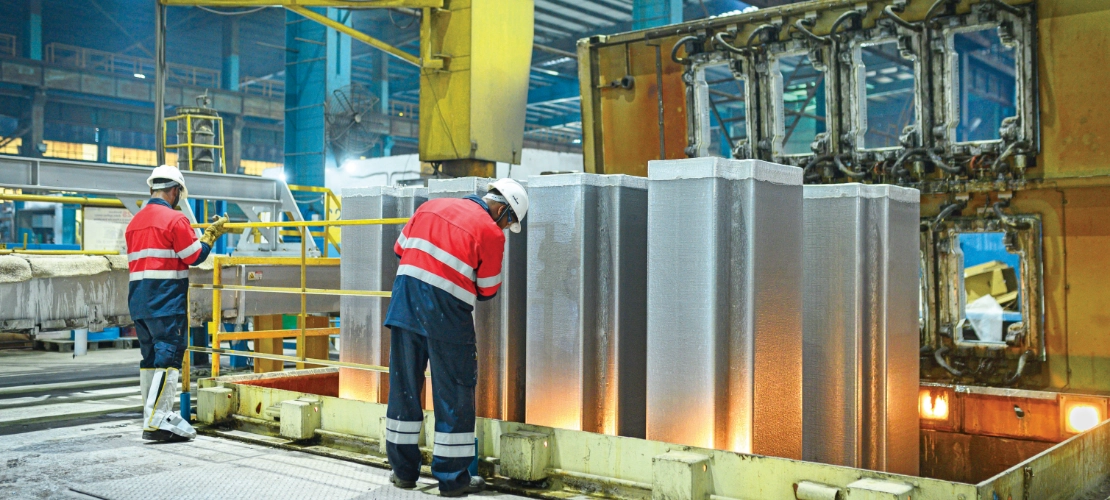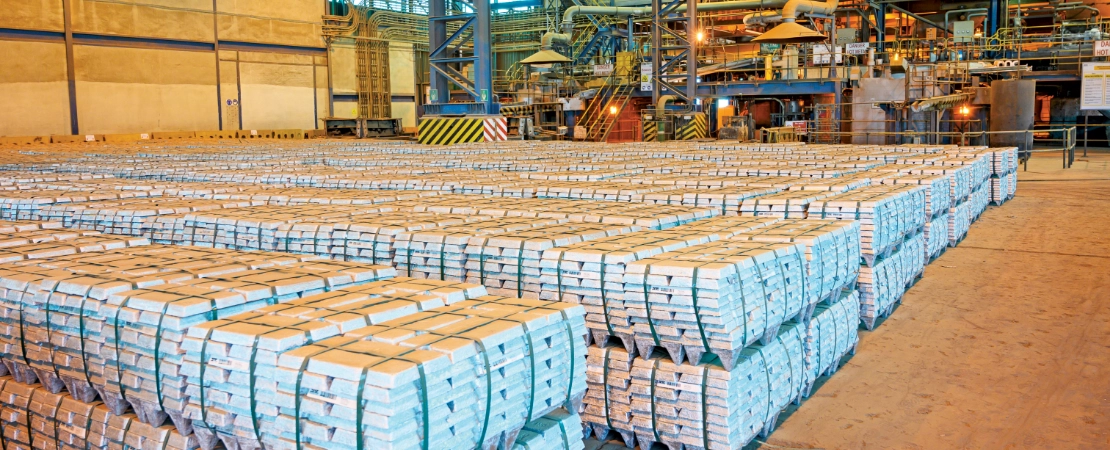
The global economy in FY 2024–25 has seen a mix of cautious optimism and a continued uncertainty. Encouragingly, inflation has shown signs of moderation across major economies, offering some relief after years of elevated price pressures. This easing trend, supported by more stable commodity prices and improved supply chain dynamics, has allowed central banks, especially in advanced economies, to hold firm on tight monetary policies without further aggressive rate hikes. While interest rate cuts have been limited, the more predictable inflation path has helped stabilize financial markets and laid the foundation for a gradual economic recovery.
However, this progress has been overshadowed by renewed geopolitical and trade tensions, particularly between the United States and China. Early in the fiscal year, the U.S. upheld steep tariffs on Chinese imports, averaging over 145%. In March 2025, U.S. also imposed a 25% duty on all steel and aluminium products, citing national security concerns. China responded with its own set of tariffs, some reaching 125%, triggering a sharp decline in bilateral trade and causing ripple effects across global supply chains.
A pivotal moment came in May 2025, when both nations agreed in Geneva to a 90-day suspension of tariffs exceeding 100%, aiming to de-escalate tensions and reopen dialogue. President Trump reduced tariffs on Chinese goods to 30%, while China lowered its tariffs on U.S. products to 10%. Despite this temporary truce, deeper issues remain unresolved, particularly around U.S. export controls on advanced semiconductors and China’s restrictions on rare earth minerals, both critical to high‑tech and automotive industries.
High-level negotiations resumed in London in June, focusing on technology transfer, export licensing, and the broader tariff framework. Yet, the U.S. simultaneously proposed to raise steel and aluminium tariffs to 50%, signalling that tariffs remain a key strategic tool.
While the tariff pause offers a brief reprieve, the path forward remains uncertain. Businesses worldwide continue to adapt to a complex and evolving trade landscape, as the global economy cautiously navigates these turbulent times.
In 2024, the global economy demonstrated resilience amid various challenges. The International Monetary Fund (IMF) reported a global real GDP growth rate of 3.3%, with emerging market and developing economies growing at 4.3%, and advanced economies at 1.8%. While this was an improvement over the pandemic years, it was still lower than pre-pandemic growth rates.
Global inflation continued to decline in 2024 following high inflation in previous years, partly due to the normalisation of supply chains after pandemic disruptions. Central banks, such as the U.S. Federal Reserve and the European Central Bank, were in a position to ease some of the aggressive monetary tightening policies they had implemented in 2022 and 2023 as inflation rates decreased. However, the disinflation stalled in certain countries and has been moving sideways, causing slower reductions in interest rate cuts.
Global manufacturing activities fluctuated in 2024 with intermittent expansion and contraction. While growth uncertainties, geopolitical tensions, and high finance costs dampen activities, falling inflation and resultant improving disposable income, coupled with easing interest rates in the later part of 2024, improved manufacturing activities. Service sector activities, on the other hand, continued to perform better with rising wages.
However, the global economic landscape has been rapidly evolving, with trade policy uncertainty emerging as the key driver of the near-term outlook. Since taking charge of the office on 20 January 2025, the U.S. President Donald Trump has significantly escalated the U.S. tariff war, implementing sweeping measures that affect global trade dynamics.
On 01 February 2025, Trump issued an executive order to impose 25% tariffs on goods from Mexico and Canada, and 10% tariffs on China with effect from 04 February 2025. As these countries announced countermeasures, within two days, that order was held back for 30 days for Canada and Mexico, without giving any respite to China.
On 10 February, the U.S. President reinforced a 25% import duty on steel and imposed a 25% duty on aluminium (raised from earlier 10% tariffs imposed in 2018), effective from 12 March 2025, ending earlier exemptions to various countries. The White House also issued an executive order to conduct an investigation into whether imports of copper pose a threat to U.S. national security.
Trump affirmed the imposition of 25% tariffs on Canada and Mexico when the one-month delay expires on 04 March. An additional 10% tariff on goods from China also took effect the same day. He also imposed 25% tariffs on automobiles and certain automobile parts, with special tariff exemptions for USMCA (United States-Mexico-Canada Agreement) compliant auto parts as well as for the value of the U.S. content embedded in autos imported under USMCA.
Major headwind came on 2 April, when the White House imposed a baseline 10% tariff starting 05 April 2025, on virtually all countries and then additional “reciprocal” tariffs starting 09 April 2025, on countries that contribute to large, persistent US trade deficits. As countries like China, Canada and the EU strongly retaliated, Trump announced a 90-day pause on differential tariffs on 09 April.
But as China retaliated, the U.S. tariffs on both sides kept rising. China imposed 125% tariffs on U.S. products with other measures, while they now face a higher tariff of 145% from the U.S.

The U.S.-led multiple waves of tariffs against trading partners have caused major policy shifts, resetting the global trade system and giving rise to uncertainty. This has overshadowed the positive developments that the world has achieved during the post-pandemic revival in the last two years. For example, from the multi-decade high inflation came down near the target levels of the central banks, encouraging them to reduce the interest rates. Labour markets also improved, with unemployment and vacancy rates returning to pre-pandemic levels.
With the world’s two biggest economies at loggerheads in a full-blown trade war, the fear of a global slowdown intensified. Heightened uncertainty has affected the consumer sentiment, discouraging them from making big-ticket expenditures. Business sentiment is also damaged, prompting many companies to suspend their capital spending plans. On top of that, inflation in the U.S. could rise again as Trump’s policies on trade, deportation, and tax are inflationary.
The newly emerged situation has triggered a downward revision of global growth prospects by the forecasting agencies. The International Monetary Fund (IMF) in its World Economic Outlook (WEO) on 22 April has dropped global GDP projection from 3.3% in 2024 to 2.8% for 2025 and 3% in 2026, down from 3.3% for both years in its January 2025 WEO Update. This is much below the historical (2000-19) average of 3.7%. Global headline inflation is now likely to decline at a slower pace than earlier expectations in January, reaching 4.3% in 2025 and 3.6% in 2026.
However, market sentiment improved after Donald Trump had said that his tariffs on China would come down “substantially” and he had “no intention” of firing the chair of the U.S. central bank, Jerome Powell. China also signalled its openness to trade talks with the U.S.
Global supply chains are grappling with unprecedented challenges due to escalating geopolitical tensions and the intensifying impacts of climate change. Trade conflicts, particularly between major economies, have led to significant disruptions, with new tariffs and protectionist policies forcing companies to diversify their supplier bases and rethink their manufacturing strategies. Regional conflicts, such as the crisis in the Red Sea, have resulted in a 67% decrease in container ship transits compared to the previous year, causing vessels to reroute and increasing transit times and costs.
Simultaneously, climate change has emerged as a critical factor affecting supply chain stability. Extreme weather events, including floods and droughts, have disrupted production and transportation networks. For instance, severe drought conditions have led to a 36% reduction in transits through the Panama Canal, further complicating logistics and inflating costs due to longer alternative routes. These environmental challenges highlight the urgent need for businesses to incorporate climate resilience into their supply chain planning.
In response to these dual challenges, companies are increasingly investing in technologies such as artificial intelligence and digital twins to enhance supply chain visibility and resilience. There is also a growing emphasis on reshoring and diversifying supplier networks to mitigate risks associated with geopolitical and climate-related disruptions. In future, the convergence of geopolitical instability and climate change is expected to continue posing significant risks to global supply chains. Businesses that proactively adapt by enhancing flexibility, investing in technology, and prioritising sustainability will be better positioned to navigate the complexities of the global trade environment.
In 2024, the U.S. economy was navigating through a period of transition, marked by uncertainty over the general election, a cooling housing market, and efforts to manage inflation. But still, the U.S. economy registered impressive growth of 2.8% in 2024, which was marginally below the 2.9% achieved in 2023.
Consumer spending, which is a major driver of U.S. GDP, continued to show perseverance, but at a more moderate rate. While the job market remained relatively strong, inflation and high-interest rates were impacting purchasing power and confidence.
The Federal Reserve had significantly raised interest rates between 2022 and 2023 to combat inflation, and in 2024, it was maintaining these higher rates to keep inflation in check. But after peaking in 2022, inflation continued to moderate in 2024, and by mid-year, inflation declined closer to the Federal Reserve’s target of 2%.
While inflation was cooling, the central bank reduced the interest rate by a cumulative 100 basis points in 2024 but remained cautious about potential price surges in the future.
But intensified trade war and tariff announcements have shifted this to a notably more pessimistic stance. In early April, J.P. Morgan Research raised the probability of a recession occurring in 2025 to 60%, up from 40%. Goldman Sachs also raised the odds of a U.S. recession to 45% from 35%. Despite direct pressure from the U.S. President, U.S. Federal Reserve Chair Jerome Powell said that the Fed would be in wait and watch mode before changing interest rates, as President Donald Trump's tariff policies could push inflation and employment further away from the central bank's goals.
While the possibility of the U.S. entering recession (defined as two consecutive quarters of negative GDP growth) appears to be low, particularly after achieving 2.9% GDP growth in Q4/CY2025, the pace of growth in the U.S. economy is vulnerable to considerably slow down if the current trade policies are retained. Growth in the U.S. is expected to slow to 1.8% in 2025 and 1.7% in 2026 from 2.8% in 2024, as per the IMF.
In 2024, China's economy showed signs of recovery after the disruptions caused by the pandemic, but it also faced a series of challenges. After a sluggish period following the pandemic's strict lockdown measures, China’s economy could achieve the targeted 5.0% GDP growth in 2024.
The growth rate was partly due to the government's efforts to shift focus from manufacturing and infrastructure investment to services, consumption, and high-tech industries. In 2024, China’s government rolled out various measures to boost economic growth, including targeted fiscal stimulus, monetary easing, and investments in green infrastructure. These measures were intended to stabilise the economy, promote consumption, and stimulate investment in key sectors. This rebalancing was part of China's longer-term strategy to move towards a more sustainable and consumer-driven economy.
A slump in housing sales has receded from -29.3% in January 2024 to -17% in December 2024 and further improved to -2.1% in YTD March 2025. Housing prices also reversed the negative Y-o-Y growth trend.
China’s industrial sector showed resilience in 2024, with strong performance in sectors like technology, green energy, and electric vehicles (EVs). The government’s push for innovation and technological self-reliance led to growth in high-tech industries, including semiconductors, robotics, and renewable energy. China’s industrial production also rose by 5.8% in 2024 and registered a robust jump of 7.7% in March 2025, mainly backed by solid export growth before the U.S. tariffs set in.
Automobile sales in China grew modestly by 4.5%, with 31.4 million units sold in 2024. But New Energy Vehicles witnessed a huge surge of 36% to 12.9 million units sold in 2024. New Energy Vehicle now holds 41% share in China’s automobile sales.

India's economic performance in FY 2024-25 has been characterised by a combination of strong growth drivers and emerging challenges. Following a splendid 9.2% GDP growth in FY 2023-24, the Indian economy is estimated to grow by 6.5% in FY 2024-25 (per the Second Advance Estimate). Weak urban consumption, persistent food inflation, and sluggish private sector investment have contributed to the economic slowdown. Except for agriculture, all other sectors registered lower growth in FY 2024-25 than the previous fiscal year, with a more notable slowdown observed in manufacturing, which is likely to have grown by just 4.3% in FY 2024-25 vis-à-vis 12.3% in FY 2023-24.

Rising trade and tariff tensions, along with resulting financial market volatility, have sparked concerns about a potential slowdown in global growth in the near term. While this subdued global outlook may affect India’s growth by weakening external demand, the country’s domestic drivers, namely, consumption and investment, remain relatively insulated from global shocks.
India is relatively better placed compared to other countries to face the vagaries of trade tension. India is less dependent on exports as export contributes just 21% of India’s GDP as compared to 87% for Vietnam or 65% for Thailand. On the other hand, private consumption fuels the economic growth, having a 61% share in GDP vis-à-vis 40% for China, 55% in Vietnam and Canada. India is also better placed as compared to its regional peers if the reciprocal tariff is triggered after the 90-day pause.
Integral to this accelerated growth trajectory and increasing economic self-sufficiency have been significant governmental reforms and considerable capital allocated towards both physical and digital infrastructure. Government initiatives such as 'Make in India' and the Production-Linked Incentive (PLI) scheme have also played a crucial role.
The services sector in India demonstrated a steady expansion of 7.2%. This growth was fuelled by strong performance across a range of areas, including finance, property, professional services, public administration, and defence, amongst others.
India's economic stature continues its upward climb, with the nation now holding the position of the world's fifth-largest economy by nominal Gross Domestic Product (GDP) and the third-largest when assessed by purchasing power parity (PPP). Ambitious national targets have been set to achieve a US$ 5 trillion economy by FY 2027-28 and a US$ 30 trillion economy by 2047. These aims are to be accomplished through substantial infrastructure investments, ongoing governmental reforms, and the widespread adoption of technological advancements. Reflecting this commitment, the capital investment budget for the upcoming financial year (2025-26) has increased to ₹11.21 lakh crore, representing 3.1% of GDP.
The outlook for the agricultural sector has improved, supported by a forecast of an above-normal southwest monsoon in 2025, which could boost farm incomes and help stabilise food prices. In March, headline inflation eased to a 67-month low of 3.3%, largely due to a drop in food prices. RBI has also reduced the interest rate by 50 basis points so far and is expected to cut more to support growth. The manufacturing sector has also shown improvement, as indicated by a strong manufacturing PMI of 58.2 in April 2025, which is the highest in 10 months.
Infrastructure development remains a major focus of the Indian government. The National Infrastructure Pipeline (NIP), with investments in roads, railways, airports, and ports, is expected to see substantial funding through 2025 and beyond. As mentioned earlier, the Union Budget for 2025-26 proposed total capital expenditure of ₹ 11.21 lakh crore and an effective capital expenditure of ₹ 15.48 lakh crore. The budget also proposed an outlay of ₹ 1.5 lakh crore for 50-year interest-free loans for states for infrastructure development.
Hence, the IMF forecasted a relatively more stable economic growth of 6.2% in 2025 and 6.3% in 2026, though it is 0.3 and 0.2 percentage points lower, respectively, than its January 2025 outlook update.
India's economy is expected to grow at a rate of 6.2% in FY 2025-26. Projections indicate that by 2030, India will likely become the world's third-largest economy, driven by investment in infrastructure, greater private sector capital expenditure, and the expansion of financial services. Ongoing reforms are anticipated to support this long-term economic advancement.
Several factors solidify this positive outlook, including India's favourable demographics, increasing capital investment, proactive government schemes, and strong consumer demand. Improved spending in rural areas, helped by moderating inflation, further reinforces this growth trajectory. The government's focus on capital expenditure, prudent fiscal management, and measures to boost business and consumer confidence are creating a supportive environment for both investment and consumption.
Programmes such as Make in India 2.0, reforms designed to improve the ease of doing business, and the Production-Linked Incentive (PLI) scheme are intended to strengthen infrastructure, manufacturing, and exports, positioning India as a significant player in global manufacturing. With inflation expected to be on target by the end of this year (2025), a more accommodating monetary policy is likely. Infrastructure development and supportive government policies will facilitate capital formation, while rural demand will receive a boost from initiatives like the Pradhan Mantri Garib Kalyan Anna Yojana (PMGKAY).
(Source: PIB, MoSPI, Economic Survey)
